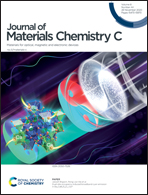Layered SnSe2 microflakes and SnSe2/SnO2 heterojunctions for low-temperature chemiresistive-type gas sensing†
Abstract
Layered SnSe2 flakes and SnSe2/SnO2 heterojunction-based chemiresistive-type sensors demonstrate good gas sensing properties at low temperatures. The pure SnSe2-based chemiresistive-type sensor exhibited good response and recovery to both NO2 and NH3 while also showing a moderate response to hydrogen, CO, C3H6 and several typical volatile organic vapors, such as methanol, ethanol, acetone and formaldehyde, near room temperature, indicating that it possesses poor selectivity. However, compared to pristine SnSe2, a SnSe2/SnO2 heterojunction-based chemiresistive-type sensor prepared by the thermal oxidation method showed greatly improved sensitivity and superior selectivity toward NO2 at 120 °C. Such impressive improvements in the sensing performance can be attributed to the formation of SnSe2/SnO2 heterojunctions. The density functional theory (DFT) calculations revealed that there was a lower adsorption energy and greater Bader charge value between the adsorbed NO2 and SnSe2/SnO2 heterojunction materials.



 Please wait while we load your content...
Please wait while we load your content...